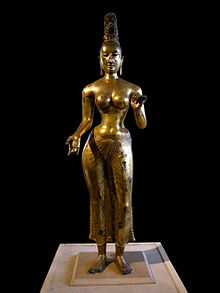
In Buddhism, Avalokiteśvara, also known as Lokeśvara and Chenrezig, is a tenth-level bodhisattva associated with great compassion (mahakaruṇā). He is often associated with Amitabha Buddha. Avalokiteśvara has numerous manifestations and is depicted in various forms and styles. In some texts, he is even considered to be the source of all Hindu deities.

Anuradhapura is a major city located in north central plain of Sri Lanka. It is the capital city of North Central Province and the capital of Anuradhapura District. The city lies 205 kilometers (127 mi) north of the current capital of Colombo in the North Central Province, on the banks of the historic Malwathu Oya. The city is now a World Heritage Site famous for its well-preserved ruins of the ancient Sinhalese civilization.
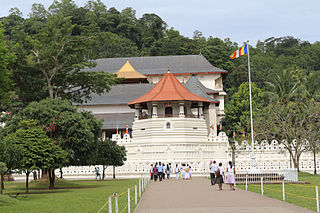
Kandy is a major city in Sri Lanka located in the Central Province. It was the last capital of the ancient kings' era of Sri Lanka. The city is situated in the midst of hills in the Kandy plateau, which crosses an area of tropical plantations, mainly tea. Kandy is both an administrative and religious city and the capital of the Central Province. Kandy is the home of the Temple of the Tooth Relic, one of the most sacred places of worship in the Buddhist world. It was declared a World Heritage Site by UNESCO in 1988. Historically the local Buddhist rulers resisted Portuguese, Dutch, and British colonial expansion and occupation.

Theravada Buddhism is the largest and official religion of Sri Lanka, practiced by 70.2% of the population as of 2012. Practitioners of Sri Lankan Buddhism can be found amongst the majority Sinhalese population as well as among the minority ethnic groups. Sri Lankan Buddhists share many similarities with Southeast Asian Buddhists, specifically Myanmar Buddhists and Thai Buddhists due to traditional and cultural exchange. Sri Lanka is one of five nations with a Theravada Buddhist majority.

The Kandyan Wars refers generally to the period of warfare between the British colonial forces and the Kingdom of Kandy, on the island of what is now Sri Lanka, between 1796 and 1818. More specifically it is used to describe the expeditionary campaigns of the British Army in the Kingdom of Kandy in 1803 and 1815.

General Sir Robert Brownrigg, 1st Baronet, GCB was an Irish-born British statesman and soldier. He brought the last part of Sri Lanka under British rule.
The SiamNikaya is a monastic order within Sri Lankan Buddhism, founded by Upali Thera and located predominantly around the city of Kandy. It is so named because it originated within Thailand. The Siyam Nikaya has two major divisions and five other divisions within these two major units. The Malwatta and Asgiriya chapters have two separate Maha Nayakas or chief Monks.
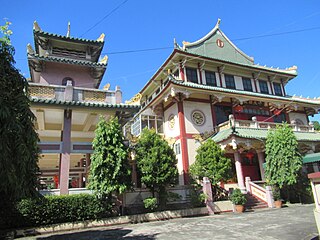
Buddhism is a minor religion in the Philippines. It is practiced by 2% of the population in 2020, primarily by Filipinos of Chinese descent.

Buddhist art is visual art produced in the context of Buddhism. It includes depictions of Gautama Buddha and other Buddhas and bodhisattvas, notable Buddhist figures both historical and mythical, narrative scenes from their lives, mandalas, and physical objects associated with Buddhist practice, such as vajras, bells, stupas and Buddhist temple architecture. Buddhist art originated in the north of the Indian subcontinent, in modern India, Pakistan and Afghanistan, with the earliest survivals dating from a few centuries after the historical life of Siddhartha Gautama from the 6th to 5th century BCE.

Abhayagiri Vihāra was a major monastery site of Theravada, Mahayana and Vajrayana Buddhism that was situated in Anuradhapura, Sri Lanka. It is one of the most extensive ruins in the world and one of the most sacred Buddhist pilgrimage cities in the nation. Historically it was a great monastic center as well as a royal capital, with magnificent monasteries rising to many stories, roofed with gilt bronze or tiles of burnt clay glazed in brilliant colours. To the north of the city, encircled by great walls and containing elaborate bathing ponds, carved balustrades and moonstones, stood "Abhayagiri", one of seventeen such religious units in Anuradhapura and the largest of its five major viharas. One of the focal points of the complex is an ancient stupa, the Abhayagiri Dagaba. Surrounding the humped dagaba, Abhayagiri Vihara was a seat of the Northern Monastery, or Uttara Vihara and the original custodian of the Tooth relic in the island.
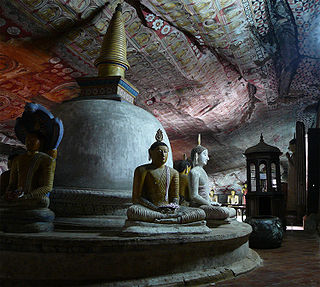
Dambulla cave temple, also known as the Golden Temple of Dambulla, is a World Heritage Site (1991) in Sri Lanka, situated in the central part of the country. This site is situated 148 kilometres (92 mi) east of Colombo, 72 kilometres (45 mi) north of Kandy and 43 kilometres (27 mi) north of Matale.

The Nayaks of Kandy were the rulers of the Kingdom of Kandy between 1739 and 1815, and the last dynasty to rule on the island. The term Nayak is derived from the Sanskrit word Nāyaka. Their rise to power came about as a result of the death of Vira Narendrasinha, who left no legitimate heir- the throne passed to his brother-in-law, who was crowned as Sri Vijaya Rajasinha in 1739. They were of Telugu Balija origin, spoke Telugu and Tamil, and used Sinhala and Tamil as their court languages. They are also credited for building various Vishnu temples in Sri Lanka dedicated to their clan deity Vishnu, known as Upulvan in Sinhala. A prominent one of them was the Kandy Vishnu Temple established at their capital Kandy. A cadet branch of the Madurai Nayak dynasty, the Kandyan Nayaks were related to the Thanjavur Nayaks as well. Both Madurai and Thanjavur nayaks belonged to Balija caste.

The Kingdom of Kandy was a monarchy on the island of Sri Lanka, located in the central and eastern portion of the island. It was founded in the late 15th century and endured until the early 19th century.
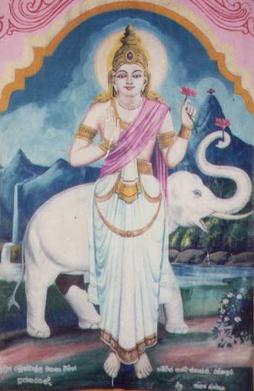
Saman is a deity, subject to local and indigenous belief and worship in Sri Lanka. The name Saman means "good minded". His character is of historical significance for the Sinhalese people and veneration especially to all the Buddhists. Maha Sumana Saman Deviraja is depicted crowned and bejeweled, holding a lotus flower in his right or left hand and accompanied by a white elephant.

In the history of Sri Lanka, the Kandyan Convention was a treaty signed on 2 March 1815 between the British governor of Ceylon, Sir Robert Brownrigg, and the chiefs of the Kandyan Kingdom, British Ceylon, for the deposition of King Sri Vikrama Rajasinha and ceding of the kingdom's territory to the British Crown. It was signed in the Magul Maduwa of the Royal Palace of Kandy.

Ridi Viharaya or Silver Temple is a 2nd-century BCE Theravada Buddhist temple in the village of Ridigama, Sri Lanka. Built during the reign of Dutthagamani of Anuradhapura, the temple is considered as the place where the silver ore, which provided silver to complete Ruwanwelisaya; one of the largest stupa in Sri Lanka, was discovered. According to the chronicles Mahavamsa and Thupavamsa, the Ridi Viharaya complex was built in gratitude for helping him cherish his dream of completing Ruwanwelisaya.

Sri Lanka–United Kingdom relations, or British-Sri Lankan relations, are foreign relations between Sri Lanka and the United Kingdom.

Kandyan era frescoes are mural paintings created during the Kingdom of Kandy (1469–1815) in Sri Lanka, a time when kings gave a special place to arts and literature.

Although currently a Theravada Buddhism flourishing country, the Mahayana cult of worshipping Bodhisattva statues has existed in ancient Sri Lanka. Archaeological evidences show that Bodhisattva cult had existed as a secondary cult inferior to worship of Buddha during the Anuradhapura period. This can be assumed by the surviving Bodhisattva statues.
The history of Theravāda Buddhism begins in ancient India, where it was one of the early Buddhist schools which arose after the first schism of the Buddhist monastic community. After establishing itself in the Sri Lankan Anuradhapura Kingdom, Theravāda spread throughout mainland Southeast Asia through the efforts of missionary monks and Southeast Asian kings.
